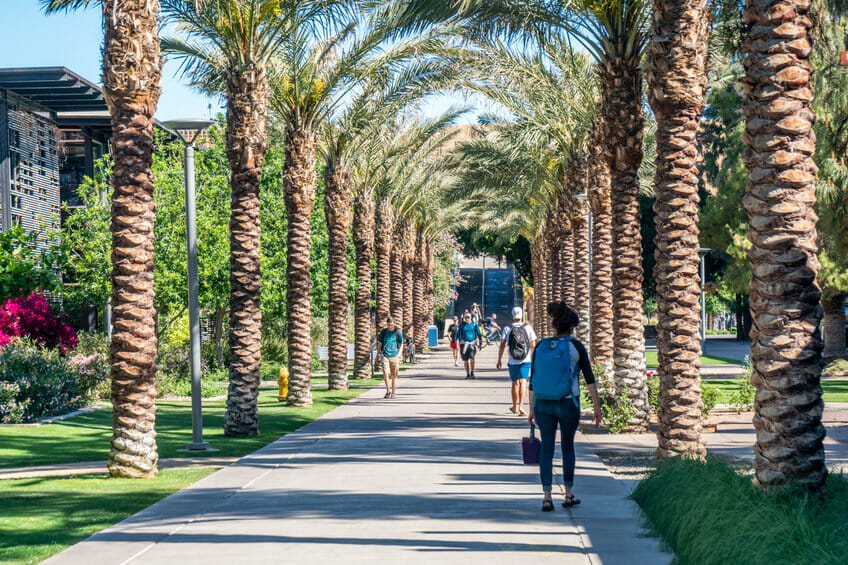Like many institutions, colleges and universities were deeply affected by COVID-19 and had to quickly readjust to ensure the needs of students were met. Now, after nearly a year and a half, these bastions of knowledge are still adapting to and learning from the challenges of the pandemic.
“A lot of people didn’t think higher education could change to meet the reality of what was going on in the economy due to the pandemic, but we showed that we could pivot and pivot quickly. Now we have to keep improving,” says Lee Lambert, chancellor of Pima Community College (PCC).
But what will post-secondary learning look like in Arizona once the pandemic is firmly in the rearview mirror? Some say higher education will largely settle back to the pre-pandemic norm in another year or two, whereas others believe a mass extinction event is on the horizon. Somewhere between these two extremes are clear and lasting changes that will have been borne from the crisis.
COVID-19 lessons
When news of an easily transmissible novel coronavirus started to dominate headlines, one of the biggest concerns were schools. These facilities concentrate people in small spaces for long periods of time, creating prime breeding grounds for the virus. Educators at every level suddenly had to figure out how to move learning online as campuses shuttered.
For Pima Community College, the necessity for migrating students online happened to align with one of the college’s initiatives. Before the pandemic, about 30% of learners were enrolled in PimaOnline, which made it the single largest Pima campus.
READ ALSO: Most Influential Women of 2021: Nancy Gonzales, ASU
“We were looking to get to about 50% of our total enrollment from online students. When the pandemic happened, it blasted through the goal because we had to move basically everything into that modality,” Lambert explains.
Some courses, however, were more difficult to facilitate virtually. Instructors of classes with a lab element had to dedicate many hours to ensure students still learned the core competencies through an online lab environment. In one case, faculty at Mesa Community College (MCC) created a take-home lab kit for a life sciences course.
Similarly, performing arts programs had to be creative in how they could safely share their work with others. “We had a group of students who wrote, produced and performed an entire musical on Zoom. The production value was outstanding,” says Nancy Gonzales, provost at Arizona State University (ASU).
The hands-on nature of career and technical education (CTE) courses, such as welding or automotive mechanics, made it difficult, but not impossible, to recreate the learning experience on a computer.
“We always thought career and technical education courses required students to come to the lab. The pandemic helped us understand that there’s a portion of that experience that could be done online,” Lambert remarks. “I think an important lesson coming out of the pandemic — we can create more hybrid pieces attached to CTE, which will I think open up future opportunities to bring more people in.”
Hybrid courses, where learning is split between online and in-person work, enable students to have more control over time spent on their studies. José Luis Cruz Rivera, president of Northern Arizona University (NAU), believes that hybrid options will continue to be attractive to students in the future.
“After a year and a half of online and hybrid instruction, many learners say that they’re not ready to go fully virtual. If they need to have 15 units a semester, they may want to have the flexibility of taking nine credit hours in person and a couple of classes online,” he says.
At ASU, a new style of instruction was introduced during the pandemic to augment in-person and online modalities. Professors deliver course content in their classrooms, while students have the option to attend in-person or through Zoom. “We understand that students really value an in-person experience, so that’s principally what we’re trying to provide for them. That doesn’t mean that we won’t continue to use some form of synchronous remote learning, what we call ASU Sync. That is here to stay because it gives us another tool that we can use in our in our broader educational approach,” Gonzales explains.
The disruptions caused by the crisis gave school administrations an opportunity to reevaluate procedures. “Some back-of-the-house processes were antiquated, and we needed to let them go or refine them. For instance, we need to be doing more electronically, so we’re not asking students to bring in a paper transcript when it can all be done online while making sure that document imaging is secure,” says Lori Berquam, interim president of Mesa Community College (MCC).
Another lesson learned from the pandemic is that many roles in colleges and universities have tasks that can be completed remotely. Grand Canyon University (GCU), NAU, MCC, ASU and PCC are developing remote work policies or implementing new plans that complement any work-from-home arrangements that were already established prior to the crisis.
Lambert says that PCC will be adopting a schedule that allows some employees to work on campus for three or four days and the remainder of time at home. “Why not increase that flexibility for people? I think the pandemic taught us that we can do it,” he argues.
Fall outlook
After spending an entire academic year under strict pandemic protocols, the Fall 2021 semester will be different than Fall 2020. Institutions now have experience from grappling with COVID-19 for nearly three semesters, and vaccines are readily available.
“There’s still a lot of uncertainty, but enrollment is up from where we were last year. A lot of that enrollment appears to be happening in our face-to-face side of the college. That’s an early indication that there is a segment of people who want to come and have that on-site experience,” Lambert notes.
Berquam describes 2021 as a transition year. “When you shake a snow globe, it takes a while for all the snow to fall to the ground. As we continue to track the impact of the Delta variant, we’re cautious about what we put in place. We recognize that if we need to pivot in order to go back to entirely online — because that’s what the nation needs for the health and safety of our students, staff and faculty — we’re ready to do that.”
In Flagstaff, NAU is preparing for students to return for in-person learning. “Our ‘Jacks are Back’ campaign expects all of our students, faculty and staff to be back on campus. We will be trying to return to where we were prior to March 2020, but soon after we get started, we will be doing a lot of reflecting on what we learned during the pandemic and how we can adapt those lessons to the future,” Cruz Rivera explains.
Brian Mueller, president of GCU, says that Fall 2021 will be noticeably different than last year. “It will look very similar to Fall 2019. Both new and total enrollments are way up. The enthusiasm that students have to be on campus is through the roof,” he says. “We’ll have vaccines available for all students who want them, and we’re going to highly encourage it. We’re also going to do a lot of education around vaccines because I think there’s a lot of miseducation out there.”
Arizona’s largest university, ASU, is inviting 75,000 students back to its campuses this fall. “We’ve learned about how to manage the pandemic. That puts us in a much better position to implement as many safety guidelines as we as we can. We’re really encouraging our faculty, staff and students to find ways to get vaccinated. Vaccines are the No.1 tool for keeping people safe. We will continue to do random testing and flexibly implement safety guidelines as needed in response to what we’re seeing out in the community,” Gonzales explains.
Post-pandemic future
When a worldwide calamity shakes the foundation of the status quo, there are always some who see it as a temporary disruption and others who predict the inevitable fall of the current system. Leaders in higher education, however, view the challenges posed by the pandemic as opportunities to improve and better serve their students. As the likely apocryphal Winston Churchill quotation goes, “Never let a good crisis go to waste.”
Rather than hearing higher education’s death knell, Berquam is bullish on the industry’s future. “I think there’s going to be gains in higher education. We offer a product that is crucial to the economy, and community colleges play a pivotal role in addressing workforce demands. I believe that community colleges are poised to offer the community what it needs,” she contends.
Gonzales adds, “Universities that adapt to the changing market demands of higher education will continue to thrive and meet the needs of students in new ways. I actually see it as a very optimistic time for higher education.”
Still, not every institution will emerge unscathed. “There will be some losses. Even before the pandemic, we were seeing some of the small private universities having trouble keeping the doors open. There’s a shift in how different higher education institutions from different sectors will approach the new normal,” Cruz Rivera states. “I would expect that others will perhaps not disappear but be bought out.”
Lee believes that students’ priorities are changing, and the pandemic accelerated that movement. “What we’re hearing consistently is people want more short-term options. The four-year degree is just one of many paths,” he remarks. “I think we have an opportunity to personalize education to individual learners so they get what they actually need versus thinking that everybody should be put in a box and get the same thing. It’s going full circle back to the one-room schoolhouse,” Lee says.
Mueller agrees that the pandemic hastened trends that were already emerging. “An upside is that consumers of higher education learned in a very dramatic way that there doesn’t need to be a single industrial model that every student has to walk through in order to be educated, earn a degree and be prepared for a career. Universities in the future are going to have to be very flexible in order to meet the consumer demand,” he notes.
Luckily for Arizona students, Senate Bill 1453, which allows community colleges to confer four-year degrees, was signed by Governor Doug Ducey in May. Since the bill was recently passed into law, the state’s community colleges are still in the exploratory process and haven’t announced any programs.
Berquam sees this legislative change as being in alignment with Achieve60AZ, a nonprofit, community-based alliance pushing for 60% of Arizonans ages 25 to 64 to hold a postsecondary degree or credential by 2030. “By offering four-year programs, community colleges will help create a more educated populace in Arizona. We’re not trying to duplicate what happens in our state or private institutions; instead, we’re trying to provide an option in a niche that these establishments don’t serve. There are enough swim lanes for us all to be successful,” she argues.
Cruz Rivera concludes, “I think 2030 is the year we will be able to look back and say, ‘This is how the pandemic, the social unrest, the economic fallout, and the political polarization translated into change in higher education.’ I expect, for example, that we’ll be talking less about US News and World Report rankings in the future and more about which institutions are doing the best in moving low-income students to the middle class and beyond.”




